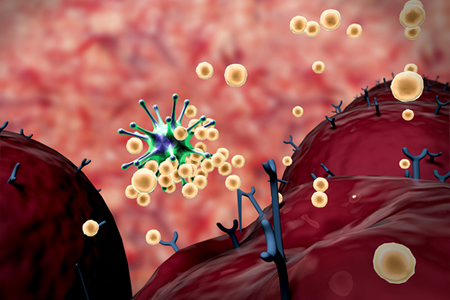A team of researchers at the University of California, San Francisco have modified the CRISPR-Cas9 gene editing tool to allow them to efficiently make genetic edits in human monocytes – the white blood cells involved in both the innate and adaptive immune systems that can give rise to the pathogen-engulfing macrophages and dendritic cells of the adaptive immune system.
CRISPR-Cas9 is a bacterial system that protects against viruses that make changes to bacterial DNA. The system has been harnessed by researchers and used to make genetic edits to human cells to remove and replace mutations and study the functions of genes. The Cas9 component is a bacterial protein that makes a cut to double stranded DNA, with the cut guided by a programmable guide RNA. The protein and the guide RNA are usually introduced into cells in a plasmid that includes the genetic instructions for making Cas9.
While it is possible to use CRISPR-Cas9 in a wide range of cells, previous attempts to use CRISPR-Cas9 for editing genes in human monocytes have proven difficult, as it was not possible to edit genes efficiently. The researchers solved the problem by adding a complex of the protein and RNA (ribonucleoprotein complex) directly into the monocytes, which gave them greater control and reduced unintended gene edits elsewhere in the genome. They optimized the conditions and were able to significantly improve the efficiency of edits without disrupting the capabilities of the cells.
The researchers were able to make edits to the DNA and remove selected genes, without affecting the ability of the monocytes to transform into dendritic cells and macrophages. The edited macrophages were shown to be capable to destroying Mycobacterium tuberculosis – the bacteria that causes tuberculosis.
To demonstrate the effectiveness of gene editing, the researchers removed both the the gene SAM domain and HD domain-containing protein 1 (SAMHD1) from monocytes, then transformed them into macrophages. This gene provides protection against HIV, but after modification to remove the gene, the macrophages were 50 times as likely to be infected with HIV.
The research will open the door for further studies of the human immune system which will help to identify the genes most important to the function of monocytes, study how infectious diseases such as Ebola, tuberculosis, Dengue fever, and HIV interact with the immune system, and could lead to new therapeutic strategies against a wide range of pathogens.
You can read more about the study in the paper – Efficient generation of isogenic primary human myeloid cells using CRISPR-Cas9 ribonucleoproteins – which was recently published in the Cell Reports. DOI: 10.1016/j.celrep.2021.109105
